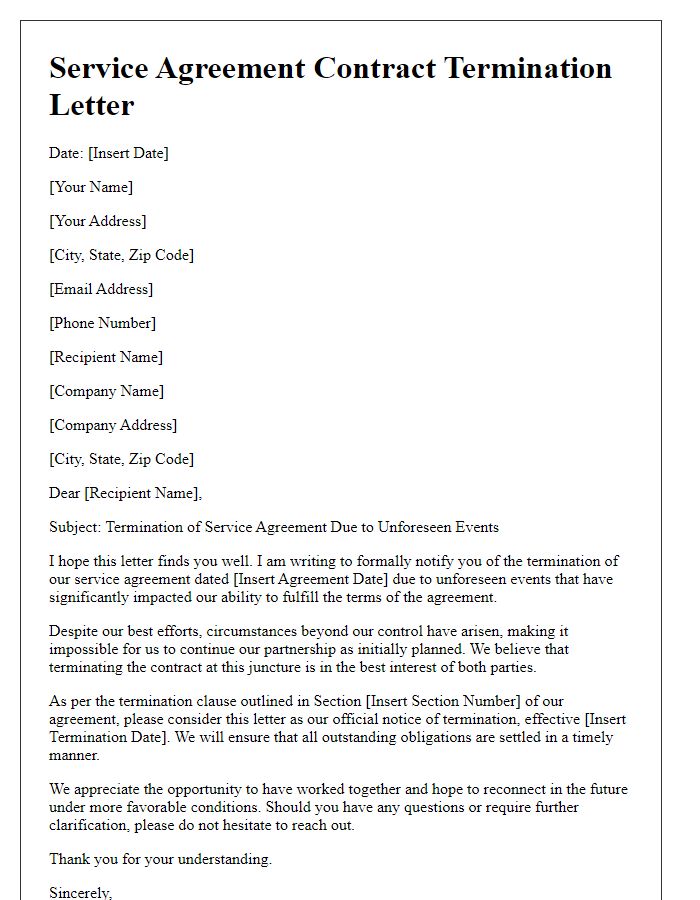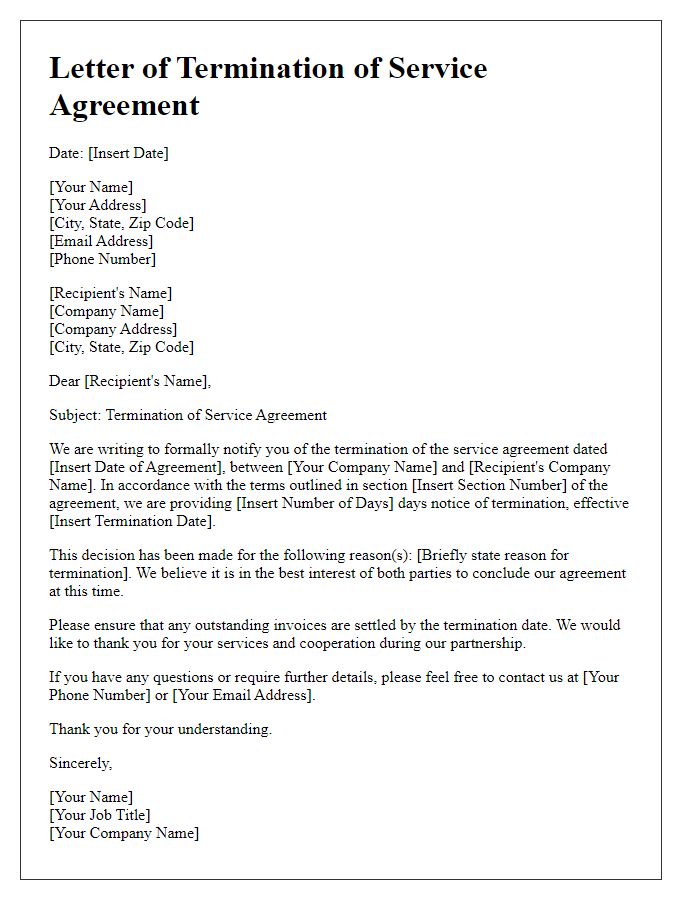Are you considering terminating a service agreement and unsure how to go about it? Crafting a clear and professional letter is essential to communicate your intentions effectively. In this article, we'll guide you through the key components of a termination letter, ensuring you cover all necessary details while maintaining a respectful tone. So keep reading to discover tips and templates to make the process seamless!

Clear Identification of Parties
Clear identification of parties is crucial in a service agreement contract termination to ensure all involved parties are properly recognized. The first party may be a business entity, such as XYZ Corporation, registered in Nevada, with a business identification number, 123456789, located at 123 Business Rd, Las Vegas, NV 89101. The second party could be an individual freelancer, John Doe, residing at 456 Personal St, Los Angeles, CA 90001, with a Social Security number, 987-65-4321. Each party's defined roles, responsibilities, and obligations within the original service agreement should be precisely outlined for clarity in the termination process. Legal entities like LLCs or partnerships may have additional considerations in identification, such as their registered agents or representative names. Clear identification avoids confusion and ambiguity, facilitating a smooth termination process and preserving the rights of both parties.
Specific Termination Date
A service agreement contract termination can occur for various reasons, including mutual consent, breach of contract, or completion of services. A specific termination date allows both parties to prepare for the transition. For instance, if a contract is set to end on December 31, 2023, both parties should ensure that all obligations are fulfilled by that date, including final payments and the return of company property. It is crucial to communicate the termination formally, providing details about any outstanding deliverables or disputes needing resolution before the specified date. This structured approach minimizes confusion and fosters a professional relationship even when ending an agreement.
Reason for Termination
Termination of a service agreement contract may occur due to various reasons, including breach of contract, unsatisfactory performance, or changes in business circumstances. The breach of contract could involve failure to meet deadlines or quality standards, impacting service deliverables. Unsatisfactory performance might refer to consistently unreliable service, poor communication, or inability to fulfill agreed-upon tasks. Changes in business circumstances can include financial difficulties, operational restructuring, or mergers that necessitate reevaluation of existing agreements. Documenting the reason for termination is crucial for future reference and legal compliance, ensuring both parties understand the rationale behind the decision.
Reference to the Original Contract
The termination of a service agreement contract can be a crucial decision for both parties involved. The original contract, signed on January 15, 2022, outlines the specific terms and conditions governing the relationship between the service provider and the client. Important clauses regarding termination notice period (30 days), obligations upon termination (settlement of fees), and the process for concluding ongoing projects must be referred to. It's essential to reference the original agreement, ensuring clarity on responsibilities such as the return of confidential information and materials. Additionally, the termination process should comply with any legal requirements stated in local jurisdiction, potentially affecting future engagements. Proper documentation of all communications related to the termination helps maintain professionalism and safeguards against disputes.
Obligations and Final Settlement Terms
Termination of service agreements often involves specific obligations and final settlement terms that must be carefully addressed. In such cases, both parties, typically the service provider and the client, must clarify the scope of work completed and any outstanding responsibilities. The billing terms should reflect any outstanding payments, including prorated amounts or refunded fees based on the duration of service rendered until the termination date. It is also important to discuss the return of company property, such as equipment or documents, and ensure that all confidential information, as per the non-disclosure terms, is handled appropriately. Any consequences of termination, including penalties or conditions for waiving such fees, should be documented clearly to avoid disputes. Both parties should ensure compliance with the notice period specified in the initial agreement and confirm that all obligations are met before final settlement. Legal jurisdictions may vary; thus, reference to local laws governing contract terminations is essential to both parties' rights and responsibilities.
Letter Template For Service Agreement Contract Termination Samples
Letter template of service agreement contract termination for mutual consent.

Letter template of service agreement contract termination due to breach of contract.

Letter template of service agreement contract termination for non-performance.

Letter template of service agreement contract termination for completion of services.

Letter template of service agreement contract termination for change of circumstances.

Letter template of service agreement contract termination with advance notice.

Letter template of service agreement contract termination for client dissatisfaction.

Letter template of service agreement contract termination for unforeseen events.

Letter template of service agreement contract termination with termination clauses reference.





Comments